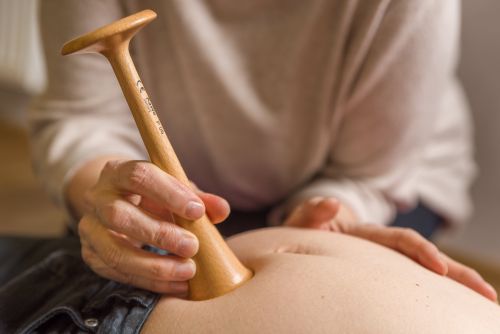Midwives | Pinard's ear trumpet
Listening with the ear trumpet - a guide
To listen to the baby's heartbeat with the listening tube, the abdomen is first palpated to determine the position of the baby and to locate its back. Where the baby's back is, the heart (and therefore the heartbeat) is closest to the abdominal wall and can be heard most clearly.

When listening, the ear trumpet is placed on the abdomen and pressed lightly with the ear - while listening, the hand is removed from the ear trumpet to avoid disturbing noises.
As a midwife, you need a lot of practice to capture the baby's heartbeat! If you want to try listening at home with your partner, you will need a lot of patience. It will be easier if a midwife helps you with your first attempt. An experienced midwife will be able to detect the heartbeat from around the 24th week of pregnancy; a clear, strong beating can be heard beautifully, especially in the last few weeks before the birth. The heart sounds are perceived as regular beats at a frequency of between 120 and 160 beats per minute - the frequency of the unborn baby is therefore about twice as high as that of the mother! It is always an exciting experience, especially for the partners, to hear their child's heartbeat in this way!
You are welcome to make an appointment for a free midwife consultation at the Hebammenzentrum to familiarize yourself with palpating the abdomen and listening to the heartbeat. One of us midwives at the center will be happy to show you how the baby is lying and where you can hear the heartbeat! In our group for pregnant women, the midwife will also be happy to feel your belly and listen to your baby's heartbeat.Wooden ear trumpets for listening at home are available from us at the Midwifery Center.
Incidentally, the ear trumpet was developed in 1895 by Adolphe Pinard, a French gynecologist, and is therefore a very popular instrument.
To the surprise of many families, the ear trumpet is still in use today! Many of us midwives use it primarily in prenatal care, but the heart rate of the child can also be counted and checked during birth with the listening tube and gives us midwives information about the condition of the child. With the right training and practice, the midwife can monitor the heartbeat anywhere and is not tied to electronic equipment.



